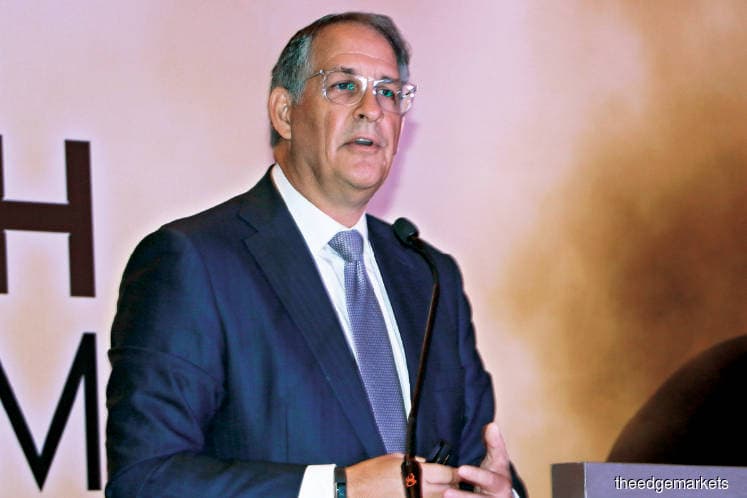
This article first appeared in Personal Wealth, The Edge Malaysia Weekly on March 26, 2018 - April 1, 2018
Investors should reset their expectations to lower returns from equities and bonds in the next five years, said Steven Moeller, managing director and head of multi-asset platform strategy for Asia-Pacific at BlackRock in Hong Kong, at the The Edge-Citigold Wealth Forum 2018.
He said the equity risk premium is expected to decline going forward. This means investors’ overall returns will be lower.
This trend is also happening in the bond space, said Moeller. For instance, the credit spread between US Treasury bonds and investment-grade corporate bonds has tightened. Those who buy into investment-grade corporate bonds now will not get the same yields as before. “As a result, investors’ returns in the long term will be more muted,” he said.
Moeller said the returns from equities globally will trend downward to about 6% to 7% while those from bonds will be in the range of 2% to 3%. He added that market volatility is expected to increase as market players are adjusting to a new economic environment where inflation rates are trending up in many parts of the world.
In his presentation, “Multi-asset investing in today’s markets”, Moeller said inflation rates are not only trending upward gradually in developed markets but also in emerging markets after many years of decline. “The International Monetary Fund has forecast that the inflation rate of emerging markets will pick up gradually this year,” he added.
Moeller said equity markets around the world were very calm last year. This is partly reflected in the S&P 500 index’s maximum drawdown rate of 2.8% — a phenomenon not seen since 1995. “The same phenomenon is common across the globe. We don’t think this will continue,” he added.
Market volatility is expected to be caused by geopolitical risks arising from trade tensions between the US and countries such as Canada, Mexico and China. The US is currently renegotiating the North American Free Trade Agreement (Nafta) with Canada and Mexico. If the US fails to reach an agreement with its trading partners, it could send shockwaves through the global market.
On top of that, the US recently imposed tariffs on products such as solar panels, washing machines, steel and aluminium. This has created tensions among other countries, including China. Market players are worried that US President Donald Trump will impose tariffs on other products and that China will retaliate in kind.
“In January, we were mainly thinking about the conflict between the US and North Korea. But this has reversed in the last two months. Instead, the trade war risk has begun to ramp up,” said Moeller.
However, he believes that Trump’s key intention behind such moves is to bargain for more favourable terms for the US in its trade agreements with other countries. “We believe this won’t disrupt the market. But we are concerned,” said Moeller.
Adopting a multi-asset strategy
Despite higher volatility and lower returns, the equity and bond markets still have legs to run as the global economy is expanding and inflation rates are gradually rising, said Moeller. Thus, investors should stay invested and remain diversified to reduce portfolio volatility. “We encourage investors to take on risk, but to do so in a diversified way,” he added.
The multi-asset strategy, which is an investment approach adopted by fund houses and hedge funds globally, is something investors can look into, said Moeller. “This strategy could benefit investors during a volatile market. It could help them achieve higher returns with minimal drawdown.”
How can this be achieved? He explained that investors who adopt this strategy look at various asset classes in the equity and bond universe. For instance, in the equity space, investors could buy into securities such as preferred stocks, index options, futures contracts, dividend futures and warrants. In the bond space, they could look at inflation-linked bonds, interest-rate swaps, yield curve trades and credit default swaps.
Investors also have the option of non-traditional asset classes such as convertible bonds, private placements, real estate investment trusts, precious metal-related securities and structured products. “All these provide investors the flexibility to manoeuvre through different economic environments while achieving higher returns with lower volatility,” said Moeller.
Investors who adopt a multi-asset strategy also focus on near-term market changes and try to take advantage of them using the flexibility they have, he added.
Investors who are interested in gaining exposure to a multi-asset strategy can invest in unit trust funds that adopt such strategies, said Moeller. That is because most investors do not have access to a broad range of asset classes in the equity and bond universe.
More importantly, individual investors are highly unlikely to possess the skill and knowledge to manage a complicated mix of asset classes to achieve their desired returns and reduce portfolio volatility, he added.
Save by subscribing to us for your print and/or digital copy.
P/S: The Edge is also available on Apple's AppStore and Androids' Google Play.